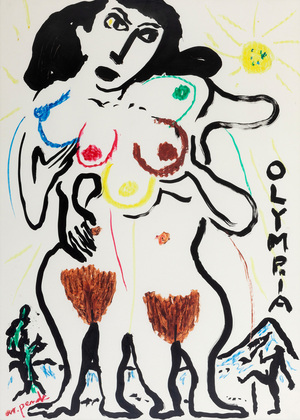Julian Schnabel and A.R Penck: the artists that CO0B'92 censored at the Barcelona Olympics
Coinciding with the 30th anniversary of the ’92 Barcelona Olympics, Setdart will tender on September 8 two unpublished works by Julian Schnabel and A.R Penck made for the world’s greatest sporting event.
On July 25, 1992, the whole world’s eyes were on Barcelona: the Olympic Games were opening in the city and for the first time in Spain a sporting event of such magnitude was taking place. Its success and impact is undoubtedly one of the great milestones that changed the history of the city to become the spark that ignited the innovative and avant-garde spirit of Barcelona. In fact, the Barcelona 92 Olympic Games placed our country on the international scene from multiple perspectives and removed an outdated and negative image that had dominated the collective imagination for years. In this sense, the story behind these two works, which will be put out to tender on September 8, gives us an idea of the scope of the project that nurtured the Spain Brand and specifically that of Barcelona.

One of the parts that made up the project that the Organizing Committee of the Barcelona Olympic Games developed was based on the creation of 58 posters whose function was to promote the Olympic image. This project, the most ambitious in the history of the Games, was grouped into four areas or collections: official Olympic posters, photographic sports posters, designers’ posters and painters’ posters. In the latter, with the sponsorship of Telefónica and the collaboration of Daniel Giralt Miracle, 10 artists were proposed to advertise the Barcelona brand, including Julian Schnabel and Penck. However, the audacity of both artists when it came to creating their respective posters led them to censorship by the COOB’92, which found the high erotic voltage of his works inappropriate. However, among the participating artists, Schnabel and Penck enjoy a greater international projection, as evidenced by their extensive exhibition curricula, as well as their wide presence in prestigious public and private collections.
In Penck’s case, his style fuses spontaneous self-expression with sobriety, as well as symbolically combining his historical influences and pop art with his political and social concerns. Likewise, in this work, the erotic component is evident in Olympia, whose representation, in addition to establishing a play on words with the event, symbolizes each of the 5 Olympic rings through her 5 exposed breasts .
For his part, painter and film director Julian Schnabel is known for being an exuberant artist with an impetuous personality and brutal frankness that he has continually reflected in his work. His artistic proposal, so surprising and risky, contains a powerful homo-erotic character that, as in this case, is made visible with the presence of the harness, whose spartan mark can establish a parallelism with the heroic figure of the Olympic athlete.
The bidding for these pieces, which were finally discarded due to the possible controversy they could have caused, is therefore an unprecedented opportunity to acquire a small part of the cultural legacy that the Olympics gave us.






